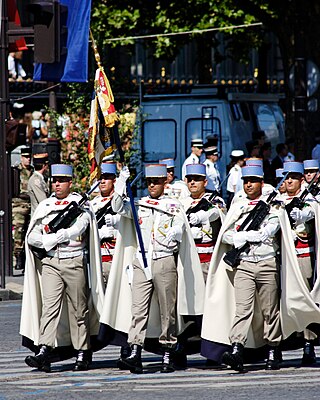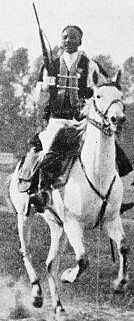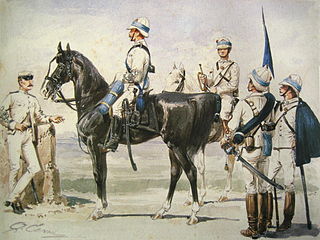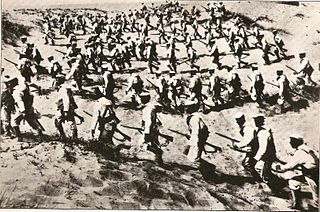
Italian Spahis were light cavalry colonial troops of the Kingdom of Italy, raised in Italian Libya between 1912 and 1942. [1]

Italian Spahis were light cavalry colonial troops of the Kingdom of Italy, raised in Italian Libya between 1912 and 1942. [1]
The Italian colonial administration of Libya raised squadrons of locally recruited Spahi cavalry immediately following the occupation of Libya, during the Italo-Turkish War of (1911–1912).
These differed from their French namesakes in that their prime role was that of mounted police, tasked with patrolling rural and desert areas, plus providing escorts and scouts. The name is the French form of the Ottoman word sipahi, a word originally derived from Middle Persian term Spah meaning "army", or "horsemen".
Although they had Italian officers these spahis were more loosely organised than the regular Libyan cavalry regiments (Savari). Newly enlisted spahis brought their own horses with them, in return for a government grant. They usually wore a picturesque dress modelled on that of the desert tribesmen from whom they were recruited. [2]
Initially raised as tribal irregulars in 1916–1919 to combat the Senussi resistance to the Italian annexation of coastal Libya, the Spahis were deployed along the Tunisian frontier in an effort to block the flow of weapons from French territory. Unlike their French Algerian and Moroccan counterparts (regular colonial cavalry also known as spahis) the Italian Spahis served as skirmishing auxiliaries armed with rifles but not sabres. [3]
Following reorganisation in the 1920s, Italian Spahis formed part of the Regio Corpo Truppe Coloniali of Libya (Royal Corps of Libyan Colonial Troops), which included desert and camel troops, infantry battalions, artillery and cavalry. The Truppe Coloniali saw extensive service during the Italian conquest of Tripolitania and mainly contributed to the full control of Cyrenaica and Fezzan, which was not completed until 1932. Subsequently, they patrolled the border areas of Italian Libya. Throughout their history the Italian Spahis were recruited almost entirely from Tripolitania; an attempt in 1927–1929 to raise detachments in Cyrenaica to patrol the frontier with Egypt, proving unsuccessful because of a failure to obtain willing recruits. [4]
In 1936, Spahis and other Libyan units took part in the Italian invasion of Ethiopia and received a "Gold Medal of Honor" for their distinguished performance in battle [5]
The Italian officer Amedeo Guillet commanded a "gruppo" of spahi irregular cavalry in Libya during 1934. The following year he and his Libyan spahis took part in the Invasion of Ethiopia.
On the eve of Italy's entry into World War II the Royal Corps of Libyan Colonial Troops comprised approximately 28,000 locally recruited personnel, including nearly one thousand Spahis. In 1940-41 the existing four squadrons of Spahis were expanded to nine, organised in three Gruppo Squadroni (Groups of Squadrons). [6]
The Libyan colonial infantry and artillery suffered heavy losses during the Battle of the Marmarica (December 1940) and were formally disbanded in January 1943 following the Italian withdrawal into Tunisia. The role of the Libyan Spahis and other horse mounted troops was limited mainly to patrol and scouting work by the demands of modern mechanized warfare. Spahi detachments were in control of Ghat and Ghadames until the first weeks of 1943.

Spahis were light-cavalry regiments of the French army recruited primarily from the Arab and Berber populations of Algeria, Tunisia and Morocco. The modern French Army retains one regiment of Spahis as an armoured unit, with personnel now recruited in mainland France. Senegal also maintains a mounted unit with spahi origins as a presidential escort: the Red Guard.
Méhariste is a French word that roughly translates to camel cavalry. The word is most commonly used as a designation of military units.

Savari was the designation given to the regular native Libyan cavalry regiments of the Italian colonial army from 1912 to 1943, in Italian Tripolitania and Italian Cyrenaica, and later in Italian Libya. The word "savari" was derived from a Persian term for "horsemen" (Savārān).

The Italian colonizationof Libya began in 1911 and it lasted until 1943. The country, which was previously an Ottoman possession, was occupied by Italy in 1911 after the Italo-Turkish War, which resulted in the establishment of two colonies: Italian Tripolitania and Italian Cyrenaica. In 1934, the two colonies were merged into one colony which was named the colony of Italian Libya. In 1937, this colony was divided into four provinces, and in 1939, the coastal provinces became a part of metropolitan Italy. The colonization lasted until Libya's occupation by Allied forces in 1943, but it was not until the 1947 Paris Peace Treaty that Italy officially renounced all of its claims to Libya's territory.

Zaptié was the designation given to locally raised gendarmerie units in the Italian colonies of Tripolitania, Cyrenaica, Eritrea and Somaliland between 1889 and 1943.

Dubat ; Arabic:العمائم البيضاء ); ḍubbāṭ: English: White turban) was the designation given to members of the semi-regular armed bands employed by the Italian "Royal Corps of Colonial Troops" in Italian Somaliland from 1924 to 1941. The word dubat was derived from a Somali phrase meaning "white turban".

The Senussi campaign took place in North Africa from November 1915 to February 1917, during the First World War. The campaign was fought by the Kingdom of Italy and the British Empire against the Senussi, a religious order of Arabic nomads in Libya and Egypt. The Senussi were courted by the Ottoman Empire and the German Empire. In the summer of 1915, the Ottomans persuaded the Grand Senussi Ahmed Sharif as-Senussi to declare jihad, attack British-occupied Egypt from the west and to encourage insurrection in Egypt to divert British forces.

The military history of Libya covers the period from the ancient era to the modern age.

Libya was a colony of Fascist Italy located in North Africa, in what is now modern Libya, between 1934 and 1943. It was formed from the unification of the colonies of Italian Cyrenaica and Italian Tripolitania, which had been Italian possessions since 1911.
The Libyan Division was a formation of colonial troops raised by the Italians in their colony in Libya. It participated in the invasion of Ethiopia in the Second Italo-Abyssinian War. The formation was reorganized into the 1st Libyan Division by the beginning of Italy's entry into World War II. In September 1940, the 1st Libyan Division, together with its sister-division 2nd Libyan Division, participated in the Italian invasion of Egypt. By December, the division was dug in at Maktila and was forced to surrender during Operation Compass.

Italian Tripolitania was an Italian colony, located in present-day western Libya, that existed from 1911 to 1934. It was part of the territory conquered from the Ottoman Empire after the Italo-Turkish War in 1911. Italian Tripolitania included the western northern half of Libya, with Tripoli as its main city. In 1934, it was unified with Italian Cyrenaica in the colony of Italian Libya. In 1939, Tripolitania was considered a part of the Kingdom of Italy's 4th Shore.

The Royal Corps Of Eritrean Colonial Troops were indigenous soldiers from Eritrea, who were enrolled as askaris in the Royal Corps of Colonial Troops of the Royal Italian Army during the period 1889–1941.

Bands was an Italian military term for irregular forces, composed of natives, with Italian officers and NCOs in command. These units were employed by the Italian Army as auxiliaries to the regular national and colonial military forces. They were also known to the British colonial forces as "armed Bands".

Libyan railways are the Italian colonial railways in Italian Libya. They are related to the development of the railways in the Italian colonial empire. This history started with the opening in 1888 of a short section of line in Italian Eritrea, and ended in 1947 with the loss of Italian Libya after the Allied offensive in North Africa and the destruction of the railways around Italian Tripoli. The railways in the Italian colonial empire reached 1,561 km before World War II.

The Cacciatori d'Africa were Italian light infantry and mounted infantry units raised for colonial service in Africa. Cacciatori units later served in Somalia, Eritrea, Tripolitania and Cyrenaica for the Italian colonial empire. Partially mechanised in the early 1920s, the Cacciatori d'Africa remained part of the Regio Corpo Truppe Coloniali until 1942.

The Allied administration of Libya was the control of the ex-colony of Italian Libya by the Allies from 13 May 1943 until Libyan independence was granted in 1951. It was divided into two parts:

The Tunisian Land Army is the ground component of the Tunisian Armed Forces. The Land Forces Command is located in Bizerte. The TAF itself was created on June 30, 1956.

The Second Italo-Senussi War, also referred to as the Pacification of Libya, was a conflict that occurred during the Italian colonization of Libya between Italian military forces and indigenous rebels associated with the Senussi Order. The war lasted from 1923 until 1932, when the principal Senussi leader, Omar al-Mukhtar, was captured and executed.

The Royal Corps of Colonial Troops was a corps of the Italian Royal Army, in which all the Italian colonial troops were grouped until the end of World War II in North Africa campaign.

The Battle of Tripoli was fought in October 1911, during the initial stages of the Italo-Turkish War, and saw the capture of Tripoli, capital city of Tripolitania, by Italian landing forces. It marked the beginning of the land campaign in Libya of the Italo-Turkish War as well as the beginning of the Italian colonization of Libya.